Before You Place Your Next Trade, Ask Yourself These 10 Questions
 A commercial airline pilot goes through an extensive pre-flight checklist to avoid any problems once that jumbo-jet gets airborne. Similarly, you must go through a trading checklist before you get ‘airborne’ and enter a live trade. But, how often do you sit down in front of your computer, open your trading platform and begin searching for trades without going through any type of checklist to make sure you’re doing things right? For most traders, this is how they operate all the time and it’s a big reason they don’t make money.
A commercial airline pilot goes through an extensive pre-flight checklist to avoid any problems once that jumbo-jet gets airborne. Similarly, you must go through a trading checklist before you get ‘airborne’ and enter a live trade. But, how often do you sit down in front of your computer, open your trading platform and begin searching for trades without going through any type of checklist to make sure you’re doing things right? For most traders, this is how they operate all the time and it’s a big reason they don’t make money.
Trading plans or checklists may seem boring to you, but if they do it’s because you aren’t thinking about them right, in fact, when you start viewing them as ‘cheat-sheets’ that can actually make you a more profitable trader, you will start looking at them from a different perspective.
A trading plan / checklist will act as a filter which you put your predetermined trading criteria in and that will act as not only a trade setup filter, but also as a trading mistake filter. We all need a trading plan to stay on track and to stay grounded – I still use a mental checklist everyday before looking at the charts. However, when beginning, you need to print this out or write it down and physically go through it each time you scan for trades, until you have made it a HABIT!
What follows is perhaps a scaled-down or thinner version of what your finalized pre-trade checklist will look like and I encourage you to expand yours so it goes into more detail and leaves no stone un-turned, so to speak. So, here is a solid foundation / example checklist for you to begin building yours from…
Technical Analysis Checklist:
1. Did I draw in key levels and trends?
Did you zoom out to the weekly chart time frame and begin the process of identifying the key long-term horizontal support and resistance levels?
Did you identify the current long-term / overall trend or market condition? Is it up-trending, down-trending or moving sideways in a large range on the weekly chart? Figure this out next.
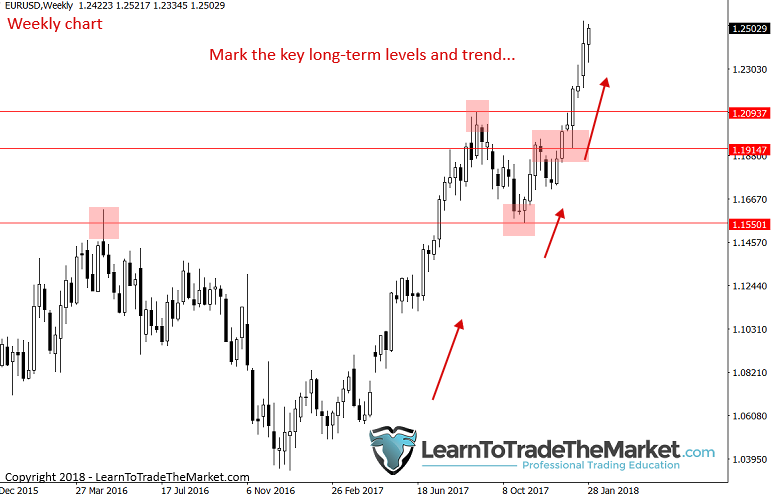
Did you then drill-down to the daily chart time frame and draw in any other obvious types of support and resistance? This would include (but not limited to) horizontal levels as well as moving averages (if trending), 50% retrace levels and event areas.
What is the near-term daily chart trend? Is there even a trend or is it consolidating in a range? Is the market just choppy? Identify if the current market movement is trending or if it’s a sideways market. The answer to this will determine how you approach this market.
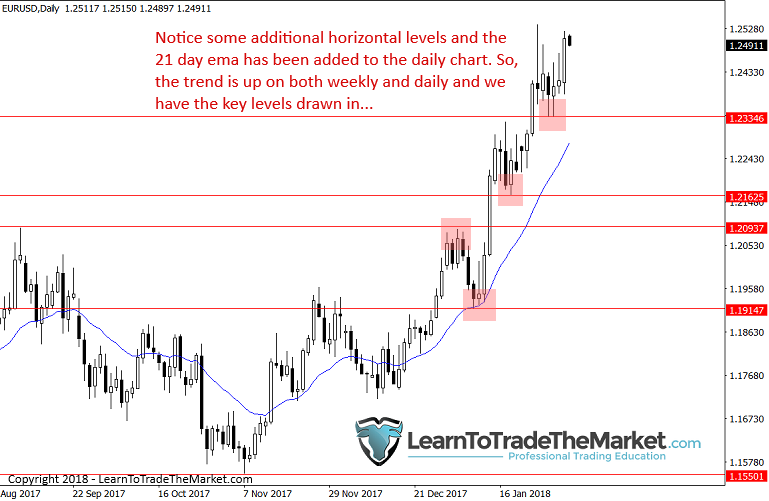
2. Is there a signal?
Next, is there something worth trading here? Is there an OBVIOUS price action signal that fits in with the current market picture? Meaning, does the signal ‘make sense’ with what the market is doing? For example: if there’s a strong uptrend in place, you are only considering buy signals, no sells. Or, if the market is range-bound you may be considering buy signals from support and sell signals from resistance. We are essentially asking ourselves IF there’s a suitable entry here, be that a price action signal or simply a ‘blind entry’; remember, we need two out of three: Trend, Level, Signal, ideally all three, but sometimes you’ll only get two of them lining up.
Most importantly, if an obvious trade setup doesn’t jump out at you on the daily, 4 hour or 1-hour chart time frame within a few minutes of looking (assuming you have honed this skill), then it’s time to move on, there’s nothing worth trading that day.
Remember, being flat (or neutral / not in the market) IS a VERY profitable position relative to taking a low-probability trade and LOSING MONEY. To learn more, checkout this lesson on how to filter good trade signals from bad.
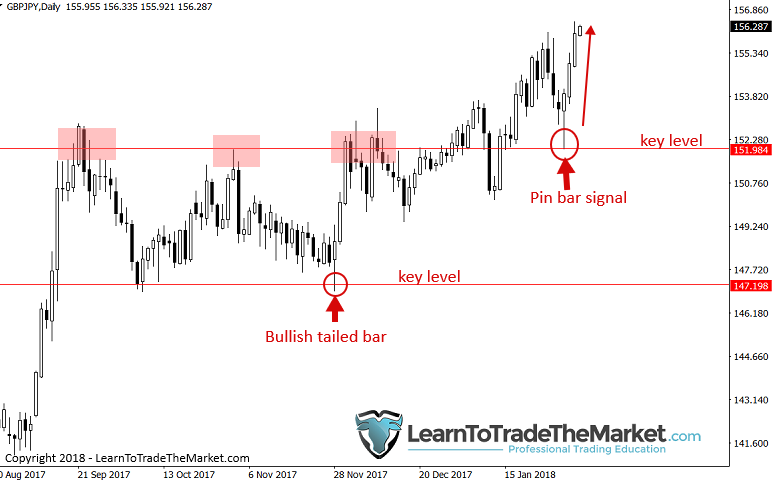
3. Is there confluence of factors / evidence?
I touched on this briefly above, but it’s so important it needs re-hashing…
If you have identified a trade signal, even if it’s an obvious one, you need to ask yourself if it is also a confluent trade setup? Meaning, does it have OTHER supporting factors behind it other than just the price bar itself? Does the trade setup make sense in the context of the story the price action is telling you? If it doesn’t, you may want to walk away from that signal. Remember, this filter / checklist is in place to make sure only the best trades make it through, think of it as a way to filter out all the garbage, leaving only the ‘pure’ trades. You are going to have losing trades no matter what, but our goal as traders is to improve our performance as much as possible and limit losses and draw-downs, well a checklist like the one you’re reading about is how that’s done.
Example of a confluent inside bar trading pattern. This signal was in-line with the downtrend and from resistance (8/21 day moving averages are red and blue lines):
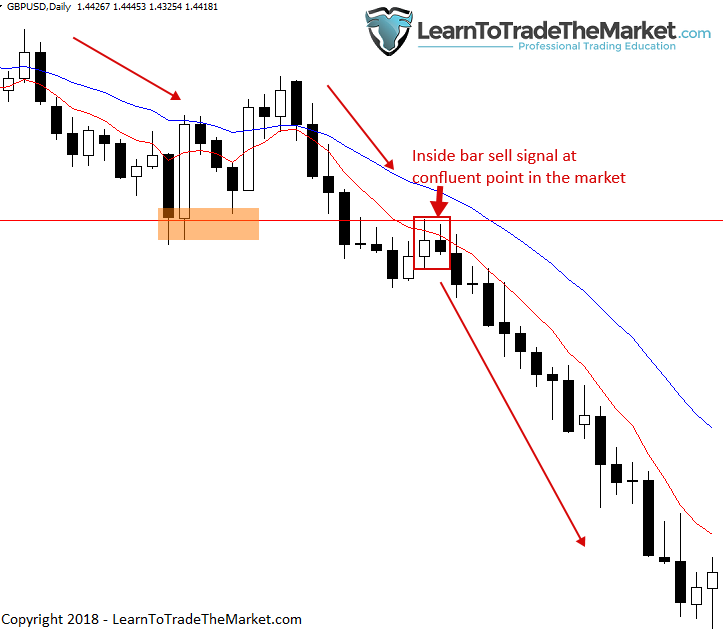
Example of a confluent fakey trading pattern. This signal was in-line with the downtrend and formed off a key resistance level…
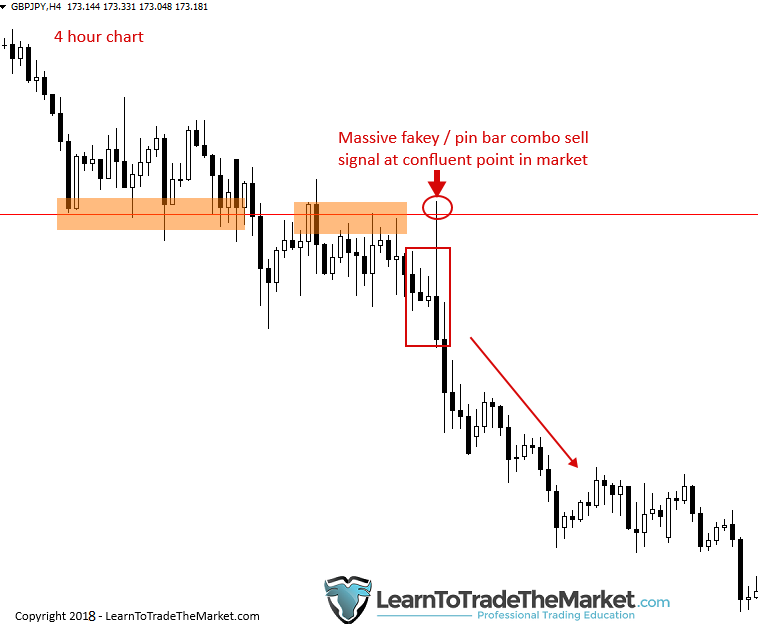
Summary of technical analysis checklist:
Identify / determine overall market conditions and levels so that you can decide which direction you are looking to trade and from where on the chart you are looking to trade. Look for high-probability entry scenarios that make sense with the previously determined market conditions and levels. You may want to make daily trading affirmations something you go through each day before you even start your checklist process or before even opening your charts. As you gain experience and master price action trading strategies, you can and should bolt-on additional entry signals and entry scenarios, make them a part of your checklist, don’t just mentally do this, not until you’re seriously skilled anyways. Remember, we are trying to re-wire your brain to develop positive trading HABITS. IT TAKES TIME, PERSISTANCE AND DEDICATION TO TURN ACTIONS INTO HABITS.
Mental / Psychology questions:
4. Am I in the right state of mind to enter this trade?
Are you in a calm, collected and overall objective state of mind before you enter this trade? Did you enter this trade for the right reasons or is it a revenge or greed-fueled trade? You will have to be honest with yourself here obviously, and you will have to act on that honesty, otherwise it’s a waste of time. Remember, you are delving into the trading world where there is no boss, no one is looking over your shoulder to keep you accountable. You must do the right thing when no one else is looking – trading is perhaps the ultimate test of one’s character!
Some other things to consider are: Did you just come off a big winning trade that may be inflating your confidence in your trading abilities to an unsafe level? Traders often lose money because they get overly confident and this causes them to take bigger / more risks in the market. Remember, you’re only as good as your last trade, so stay focused and remain in the proper trading mindset or your last trade might negatively impact your next one.
5. Am I mentally and financially prepared to accept this risk?
Ask yourself before entering a trade, are you mentally prepared for the results of the trade, win or lose? This is where trading education great Mark Douglas shines, he gets in-depth into the psychology of trading and really hammers-home the point that every trade’s outcome is essentially random, a 50/50 shot, and that is how you need to view it. However, that doesn’t mean that overtime, over a SERIES OF TRADES your edge is only 50/50. It means that there is a random distribution of wins and losses for any given trading edge. So, you could have 20 losses in a row followed by 40 winners in a row (rare, but possible). However, that is a 66.6%-win rate over the series of 60 trades. But, most traders cannot mentally withstand even a few losses in a row, let alone 20, do you catch my drift here?
You must remember that any one trade, looked at in a vacuum / apart from the rest, simply doesn’t matter. As a result, you need to think and behave in agreement this fact. Meaning, if you are analyzing your trading performance, you cannot care AT ALL about any one trade, it is the overall results, the series of many trades that proves your performance. It will do you a WORLD OF GOOD to remember these points every time you’re about to enter that next trade. This attitude and approach is part of my set and forget trading philosophy. Remember, you must let your trading edge play out sans interference on your part, otherwise you cannot properly gauge its performance over-time as a trading approach.
Money and Trade Management Questions:
6. Do I know my per-trade (1R) risk amount?
If you don’t have a pre-determined risk amount where (1R = dollars risked), you are probably not making money as a trader. You need to sit down and determine how many dollars or euros or pounds or whatever, you can realistically afford to lose per trade. Make this an amount you could potentially lose 10 to 20 times in a row and still be financially and mentally stable. I always tell traders to do a simple sleep test for risk, in which they let their ability to forget about their trades and sleep soundly determine if they’re risking a healthy amount for them, or not.
7. Did I use position sizing properly?
Did you apply the correct position size to the trade? This goes together with question number six, above. If you don’t understand position sizing, please read my article on risk reward and position sizing, to learn more. But, to put it succinctly, position sizing means adjusting the number of lots (your position size) to meet your pre-determined 1R risk amount per trade whilst considering your stop loss placement, which we will talk about next. Always determine stop loss placement before position size. You risk per trade should stay the same. You find the best stop loss placement to give the trade a good chance of working out (don’t put stops too close) and then you adjust your position size to meet your 1R risk.
8. Is the risk reward there, realistically?
Is the risk reward there? Meaning, is there a logical profit target available relative to nearby key chart levels that allows you to get a 2 to 1 winner or more? You need to make sure that your stop loss and profit target both make sense in the context of the surrounding market structure, to learn more about this, checkout my article I wrote a few years back on how to place stops and targets like a pro.
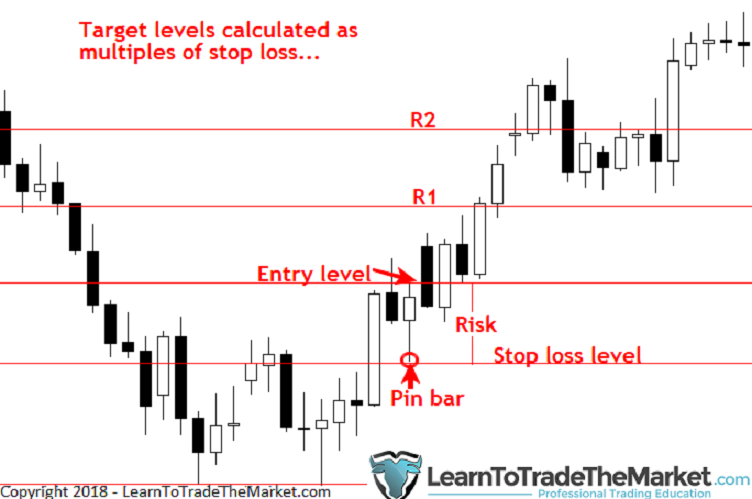
9. Do I have a plan to exit this trade?
Do you have an exit plan for this trade? What is your overall plan to exit this trade for either a win or a loss? Are you planning to exit at a certain horizontal level or are you planning to trail your stop and let the trade run because it’s in a strong trend? Will you move to breakeven at a certain point or just set and forget? These details should be ironed-out before entering the trade. If a dramatic turn of events happens whilst the trade is live (like a huge price action reversal against your position, for example) you can intervene, but in most cases, you want to pre-determine your exit strategy and stick to that no matter what. Checkout my guide to trade exits for more on this.
10. Does it fit my trading plan?
Finally, if you’ve answered all the above questions successfully, then your answer to this last question should be “yes”. Your trading plan can be a checklist like this, although yours will be more detailed, and only if a trade passes each filter should you give it the “OK”. Don’t worry, eventually, the process of going through each filter will become a habit and something you almost don’t even need to think about it. You will intuitively know if a trade passes all your filters and criteria because you will have gone through your checklist / plan manually so many times that it will have seared itself into your brain, it will become part of you.
Conclusion
We all need guidance in life, we all need mentors to improve and excel. I can be your trading mentor by teaching you what I know and what I have learned via my trading courses and members community, but it’s up to you to put in the ‘hard-work’ and follow-through with what you learn. Today’s lesson is another piece of the trading puzzle; you need to actually make a checklist like this and put it to use in your day-to-day trading and if you do, I guarantee you will see an improvement in your trading. You are going to naturally be more selective and methodical regarding which trades you take and how you trade the market.
Make this trading checklist a part of your daily trading routine and you will wonder how you ever traded without it.
What did you think of this lesson? Please share it with us in the comments below!






I have never seen the great teacher like you continue to help those who want to learn more thanks sir
This Article was a breath of fresh air, it explained almost everything i was looking for in my studying today. There are some very useful tips in this article I even add to my checklist to improve my trading. Thank you very much for those tips.
I love it so much, I’m practicing a lot for currently
always on point
Good lesson. Thanks
Am so much grateful for this insightful piece.
If I had to pick only ONE lesson to learn how to trade properly, this would be the one.
Thanks Nial.
Mr. Nial! a lesson super, thank you, right now I will create for myself this check list, you the real lifesaver)
This is very informative. As a beginner in this field, this helps me a LOT. Thank you.
Hi Sir
Your articles are a rescue in my trading journey as a beginner since I am still doing a demo.This article opened my eyes ,I was struggling to enter a trade ,do not know about trend , level and singnal.Thank you,may God bless you.
I like ur style off trading….
You will always be my mentor
Am so happy I have you
Thanks a lot Nial.
Nial am so grateful for you.
You are the best man.
Thanks nial for this lesson and your time more grease to your elbow.
smart and clear guidance
Hi Nial I notice that hardly any of the levels you draw on the latest trend in item 1. are lined up with previous lines of S&R, I cant see much point in drawing these after the price has been there, except they might be handy when the price eventually retraces/trends back down to those levels.
:)
Very powerful
Thank you so much.
Thanks for constantly reminding me the essentials of trading.
Nial you truly my mentor with such info i have seen alot of improvement in my trading.
of course every week i now see blues (profits) on my trading platform.
Thanks Nial. Great article for keeping you focused. cheers.
Absolutely brilliant article. Thank you so much. You are the best
Hi, my friend tell me about your website den i started to read every information you posted . in June 2017, i manage to invest $1100. I applied almost everything u teach in https://www.learntotradethemarket.com , i have improved a lot , until now i never go below money i have invested… i withdrew many times ,your approaches to market is very accurate and effective. yesterday i read your article about “Before You Place Your Next Trade, Ask Yourself These 10 Questions” i was happy about it because it proves how i was trading.
Thanks Nial Fuller ,may God bless you…
Hi Nial
Finally I joined your mentorship programme as full time member and looking forward to improve in the area of technical analysis.
God Bless
Thank you Nial! A sequential, easy to understand, laid out checklist with hyperlinked references that I can always go to for another better take of assurance, whilst anticipating for a trade.Again, thank you Nial!
thanks mentor
thank you Nial wonderful article.
your are a helper of destiny …you have try your best more than any one i ever come accross thanks my mentor
Great article. I read it twice, and see how important this truly is. Will definitely put this into use. Thanks Nial.
Great reminder and a lesson. I have a question, though. Do I get to H4 to check for a signal and if I dont find one there I go to H1, or I should choose one of these time frames and look for a signal only there.
Thank you very much, Nial!
Regards,
Christian from Philippines
Amazing advice and great lession, thank you for this.
Another effectual article…
Thanks alot Nial.
O.K. check, check and check, seat in upright position, seat table sowed, and ready for take off to the moon, but slowly and methodically, with discipline and patience. Thanks for the timely reminder lesson.
Thank you very much Nial, this is an eye opener for me, I really appreciate your help in this regard nd I’m printing my checklist right away! !
Regards
Lungile (South Africa)
Hi. I. Also from South Africa
Great piece of writing
NIAL, Checklist is the foundation,always on point.God bless you.
thanks Nial
Big words for lifetime in trading
Feels nice when you notice that you have entered the same signal as Nial! (GBPJPY)
Thank you Nial for your top-notch education.
Thank you sir.
I go through a checklist, mine is quite short but it has done wonders for my trading.
nice
Printing out my checklist right away!
I read a lot and try to get my trading up and running. Wat I like the most about your lessons , is that you call a spade a spade.
After I read this lesson I felt guilty about my approach.
I am going to study and to implement what you wrote.
Thanks for your honesty.
Johan Jacobs
South Africa
Amazing advice Nial thank you for all your insights and teaching fantastic set of information !!!